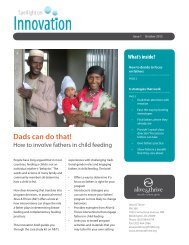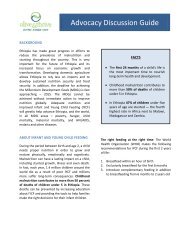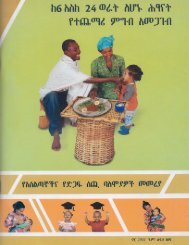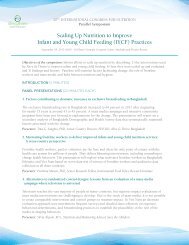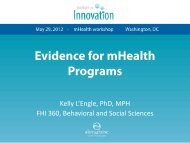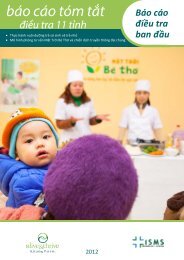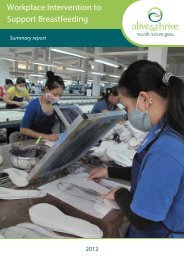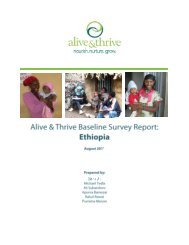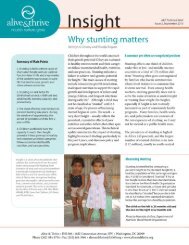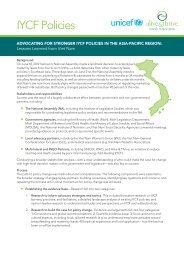IYCF Practices, Beliefs, and Influences in SNNP ... - Alive & Thrive
IYCF Practices, Beliefs, and Influences in SNNP ... - Alive & Thrive
IYCF Practices, Beliefs, and Influences in SNNP ... - Alive & Thrive
Create successful ePaper yourself
Turn your PDF publications into a flip-book with our unique Google optimized e-Paper software.
HEWs. Most mothers who talked about chang<strong>in</strong>g their <strong>in</strong>fant feed<strong>in</strong>g practices said that they did sobased on recommendations from HEWs.“I got <strong>in</strong>formation on child feed<strong>in</strong>g from HEWs. After the establishment of the health postwe have changed our practice. Previously we used to prepare gruel only from sorghum butnow we got advice <strong>and</strong> we use rye, lentil, macaroni, barley, sorghum, teff, l<strong>in</strong>seed, <strong>and</strong>butter.” - A mother <strong>in</strong> Mareka“The HEWs taught me about breastfeed<strong>in</strong>g <strong>and</strong> additional foods. They advised me to giveonly breastmilk for the first six months <strong>and</strong> start additional foods after that. This was notthe way I brought up my other children.” -A mother <strong>in</strong> ChenichaHowever, the HEWs also said that they feel less confident that their advice is be<strong>in</strong>g followed. Whilemany told of situations where they had been successful <strong>in</strong> persuad<strong>in</strong>g mothers to change a feed<strong>in</strong>gpractice, HEWs <strong>in</strong> all communities said there are challenges <strong>in</strong> gett<strong>in</strong>g mothers to follow advice. Theyexpla<strong>in</strong>ed that some mothers prefer the normal culture over the recommendation, say<strong>in</strong>g that “weeducate but they don’t practice,” “we teach but they resist,” <strong>and</strong> that they said that they feel that somemother’s don not trust them.Materials produced under two previous USAID-funded projects, Essential Services for Health <strong>in</strong>Ethiopia (ESHE) <strong>and</strong> LINKAGES , have been distributed to area communities as well as the guidel<strong>in</strong>esfor the community-based nutrition approach. HEWs <strong>in</strong> all three locations received materials from thehealth center or woreda health office, with only one HEW say<strong>in</strong>g she had no materials. These materials<strong>in</strong>cluded family health booklets <strong>and</strong> two types of posters, one with pictures of a well-nourished child <strong>and</strong>a child with malnutrition, <strong>and</strong> another with the feed<strong>in</strong>g guidel<strong>in</strong>es. Some of the HEWs also were <strong>and</strong> areus<strong>in</strong>g the counsel<strong>in</strong>g cards. HEWs f<strong>in</strong>d the family health booklets very useful <strong>in</strong> work<strong>in</strong>g with mothers<strong>and</strong> the posters appear to be popular for work<strong>in</strong>g with the community.When asked about their own knowledge <strong>and</strong> skills for counsel<strong>in</strong>g, all of the HEWs expressed <strong>in</strong>terest <strong>in</strong>learn<strong>in</strong>g more about child feed<strong>in</strong>g. Most said that they have some knowledge but need tra<strong>in</strong><strong>in</strong>g todevelop more skills <strong>and</strong> confidence <strong>in</strong> advis<strong>in</strong>g mothers <strong>and</strong> families. Several po<strong>in</strong>ted out that they needmore detailed <strong>in</strong>formation about additional foods, types of foods, <strong>and</strong> best approaches for prepar<strong>in</strong>g foodfor young children. In <strong>in</strong>terviews, HEWs demonstrated fairly good knowledge on feed<strong>in</strong>grecommendations <strong>and</strong> appropriate messages <strong>and</strong> advice. However, most HEWs reported that childrenare not gett<strong>in</strong>g enough food or the right types of food, <strong>and</strong> they question whether families can adoptthese practices because they have limited <strong>in</strong>come <strong>and</strong> lack the ability to get or buy key foods. HEWshave the basic knowledge on feed<strong>in</strong>g recommendations, <strong>and</strong> perhaps what is needed now is to focus onpractical solutions that allow families to feed their children with what they have or what is easilyobta<strong>in</strong>able.Voluntary Community Health Workers. Though active <strong>in</strong> the community, VCHPs work more <strong>in</strong>sanitation <strong>and</strong> hygiene <strong>and</strong> family plann<strong>in</strong>g <strong>and</strong> were found to be less <strong>in</strong>volved <strong>in</strong> <strong>IYCF</strong>. There aremany types of community health volunteers <strong>in</strong> each community, <strong>in</strong>clud<strong>in</strong>g health promoters, latr<strong>in</strong>e <strong>and</strong>sanitation specialists, reproductive health volunteers, health <strong>and</strong> disease prevention agents, <strong>and</strong>traditional birth attendants. Two VCHPs were <strong>in</strong>terviewed <strong>in</strong> each community <strong>and</strong> all were maleexcept for one young female reproductive health agent. Two VCHPs were men <strong>in</strong> their late 30s <strong>and</strong>28



